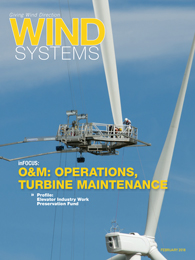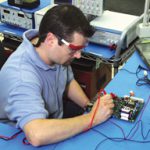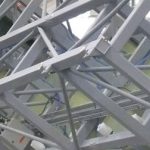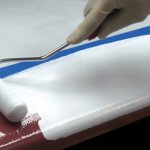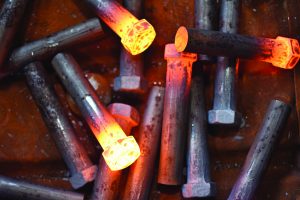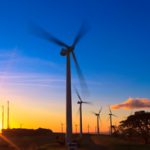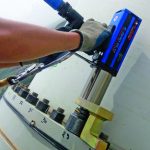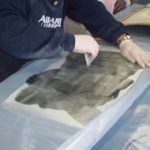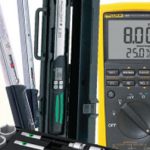Wind turbines continue to provide alternatives to conventional energy production. These mammoth structures offer challenges to the worker who has to navigate at great height while transporting tools and equipment.
Some, not all, are equipped with a wind-turbine tower elevator affording a safer option than climbing hundreds of feet to get to work.
Like a family car, home, or any machine, these elevators need to be maintained in order to provide reliable safe vertical transportation. Properly working, the benefits include safety, reduction in ergonomic risk, and increased work efficiency reducing cost. A wind farm can have dozens of turbines and those with elevators can improve employee retention by a reduction in the physical challenges.

“By using the licensed National Elevator Industry Education Program (NEIEP) mechanics to service the elevators in wind turbines, they will run more efficiently and reduce risk of injury to those accessing the Nacelle” said Carisa Barrett, national coordinator with the Elevator Industry Work Preservation Fund (EIWPF).
Who is the EIWPF?
EIWPF is a Labor Management Cooperation Committee. One of EIWPF’s specific goals within the wind industry focuses on safety.
“We have several programs within the EIWPF, and our main concern is safety of those riding and working on all conveyances,” she said. “We have OSHA master instructors who train the trainer for NEIEP apprenticeship instructors. We sit on many industry-related code committees ensuring safety for the elevator constructors who work on the elevators, the wind techs that use the elevators, as well as any others riding the elevators.”
Different elevators, different standards
“EIWPF’s reach spans the entire elevator industry; there are hundreds of different standards for different types of elevators” Barrett said. “For elevators in wind turbines, it would be ASME A17.8 standard for wind-turbine tower elevators that has recently been created. We sit on committees that write these codes. Our committee participation is there to improve safety for all who work on or ride elevators. I sit on the A17.8 committee. I also sit on the wind standards committee within AWEA, as well as the Operations and Maintenance Working group specifically under the sub group ‘towers,’ which encompasses the wind-tower elevators.”

Best practices
One of the O&M working groups responsibilities is to publish the Operation and Maintenance Recommended Practices Manual, which is updated every year,” according to Barrett. Members of AWEA can find this manual on the AWEA website.
“You can find the chapter on elevators in wind turbines on page 404 of the manual,” she said. “There you will find the codes associated with wind-turbine elevators and where you can get these code books.”
 “The adoption of these national codes and standards can change from municipality to municipality or, from state to state, according to Barrett
“The adoption of these national codes and standards can change from municipality to municipality or, from state to state, according to Barrett
“Thirty-two states have adopted some form of elevator rules,” she said. “So, in 32 states, most likely, you’re going to have to use a licensed elevator mechanic.”
Barrett said that she has seen a big increase in the wind industry using IUEC signatory elevator companies to work on, and do compliance inspections on wind-turbine elevators.
Cynthia Cuenin, who founded Tempest Group, Inc. in 2013 and is signatory to the IUEC, told Barrett that between 2013 and 2017, she had triple-digit increases. 2018 is still trending straight up for Tempest Group.
“The EIWPF participating companies represent over 450 elevator companies throughout North America, Barrett said. “We have companies in every state and major city that can professionally keep your elevators safe and reliable. There are over 27,000 members in the United States and Canada who work for these 450 companies. So there’s no shortage of manpower.”

Importance of training
There’s a reason why properly trained elevator mechanics are important, according to Barrett.
“By having NEIEP trained elevator mechanics working on your equipment, you know it’s going to be maintained properly and working safely and efficiently because that’s what our elevator constructors do,” she said.
Those mechanics have completed a four-year apprenticeship-training program requiring eight semesters of classroom instruction along with 8,000 hours of on-the-job training, as well as a cumulative mechanics exam to graduate, according to Barrett.
“Our mechanics aren’t done with their education though,” Barrett said. “NEIEP offers a growing variety of ‘continuing education’ courses that they use to assist in staying up on the ever-changing conveyance world.”
With the expansion of clean wind energy, EIWPF’s signatory companies stand ready and able to fill the need for trained professional workforce, according to Barrett.
“We are here to assist the wind industry with elevator contractors that have a highly educated and motivated work force for all of your vertical transportation needs,” she said.



















